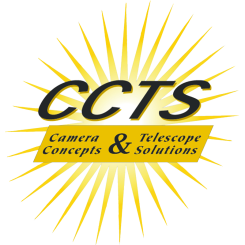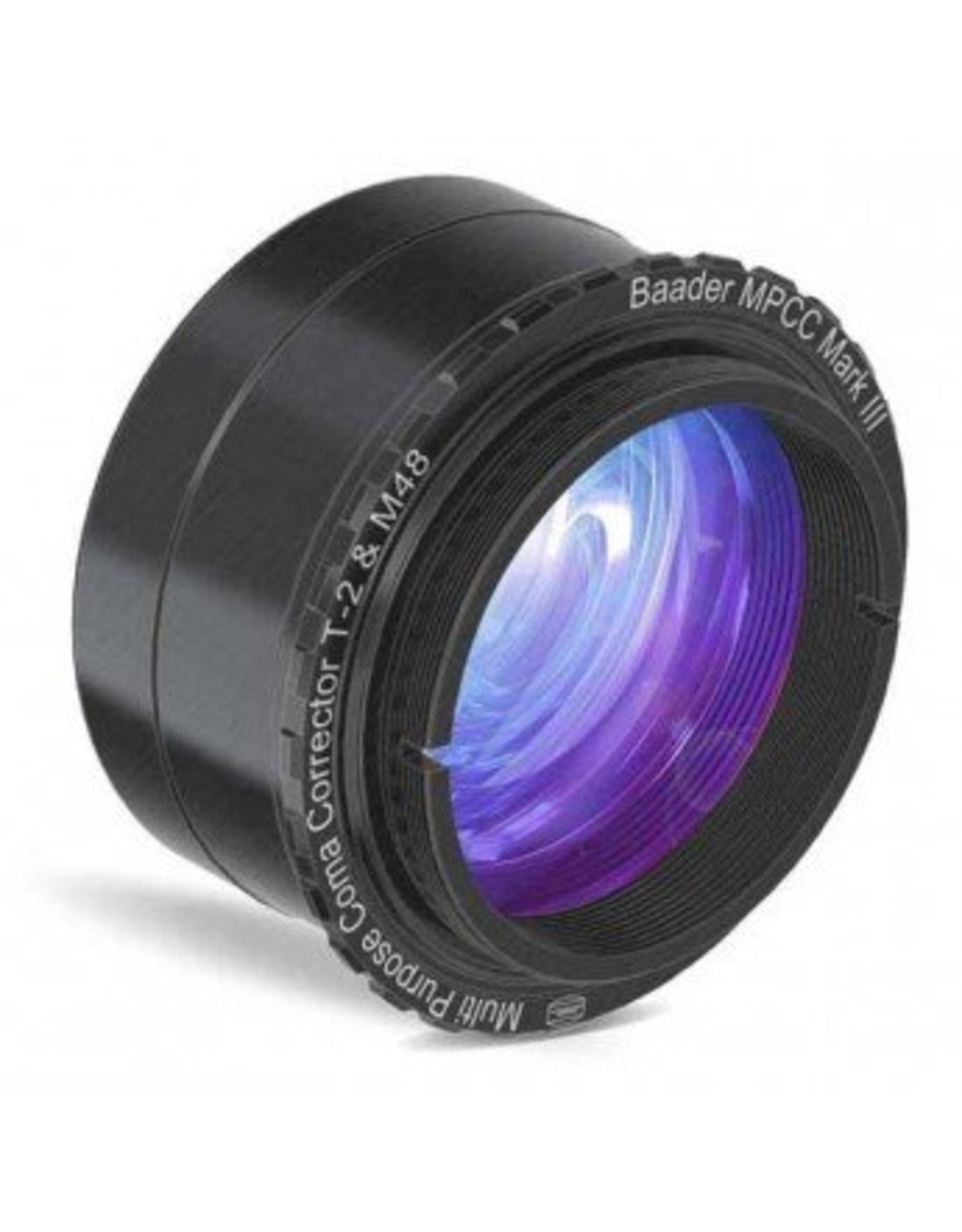Baader Planetarium 2" Mark III Multi Purpose Coma Corrector - MPCC
| Article number: | MPCC |
| Availability: | More on the Way to us |
| Delivery time: | More on the Way to us |

MPCC Mk III (ready to attach to any DSLR or CCD Camera) |
MPCC Coupled to 2" eyepiece
|

MPCC Mk III (Exploded View) |

MPCC Configured for 1¼" Eyepieces |
This superb coma corrector has a thread for 48mm filters and won't vignette!
The new Baader Planetarium MPCC MkIII enables owners of fast Newtonian telescopes to use their instrument for taking stunning wide-field images, or visually, for delivering wide-field views with stars that remain pinpoint to the edge - with no magnification increase!.
The MPCC has been optimized for Newtonians with focal ratios from f/3.5 to f/6, and will deliver 12micron stars across a full 35mm frame size. Independent optical laboratory tests (by ITE) have confirmed that the MPCC is the sharpest wide-field coma corrector available for imaging, and provides the best edge of field illumination (least vignetting). Visual users have reported great results even down to f/3.5. The optics are anti-reflection coated with Baader's PHantom Group Multicoatings. The MPCC is also priced very reasonably. It's modularity lets you purchase only the parts you need. For imaging with DSLRs, only the MPCC is required (for the maximum field size, the MPCC MkIII is designed to work perfectly with the Baader Protective EOS T-rings). For visual, the MPCC MkIII can be configured with any of our eyepiece holders or directly coupled to 2" eyepieces using Astro T-2 System components.
New Features of the MkIII Version:
- New Optical Design - calculated for an unvignetted field down to f/3.5.
- Improved sharpness across the field.
- Phantom Group© Multicoated for maximum transmission and freedom from reflections from UV to NIR.
- Attaches directly to the Baader Protective EOS T-ring through use of the optional adapter.
- 44mm Clear Aperture when using the M48 (2") filter thread or the Protective T-ring.
VISUAL
Dob users with f/3.5 - f/5 scopes have been discovering the unique benefits of the MPCC versus other coma correctors. The MPCC can be inexpensively configured for visual use with 1¼" and 2" eyepieces. Please see our MPCC Visual Configuration page for new information on some exciting visual configurations.
- No Magnification Increase: The MPCC delivers full fields for the widest 2" eyepieces. Why spend the big $$ on a large widefield eyepiece, only to have its field squeezed by the coma corrector. Now, a 31mm ultra-widefield eyepiece can perform like a 31mm, and not a 26mm.. Also, unlike some correctors, the MPCC has minimal effect on the eyepoint and blackout behavior of long focal length eyepieces.
- No additional Back-Focus (in-travel) Required: In fact, in direct-coupled configurations, the MPCC actually increases back-focus by about 10mm. If your eyepiece will focus without a coma corrector, it Will reach focus with the MPCC. This is not the case with some other coma correctors.
- Reduced Vignetting: The new MPCC MkIII now works even better with the largest true field 2" eyepieces. Due the closer position of the field lens to the focal plane, the MPCC MkIII is able to provide a larger fully illuminated true field than any other coma correctors (both visually and photographically)
- Low Cost: The MPCC is priced lower than other correctors. Some users have even purchased more than one and leave them permanently attached to their favorite 2" eyepieces.
IMAGING
|
MPCC MkIII - with Baader Protective T-ring |
Exploded View |
The MPCC is the perfect match for today's Digital SLRs. Owners of these new cameras find them to be ideally mated with today's fast f/3.5-f/5 Newtonians required to keep exposures short. The MPCC enables these users to fully correct their scopes and produce superb pinpoint color deep sky images without the complexity of more expensive CCD astrocameras. Owners of Vixen Newtonians will appreciate the inclusion of filter threads, and the high sharpness of the images. Unlike other coma-correctors, the MPCC does NOT extend the focal ratio (so, your images will be shot at the full speed of your telescope).
The MPCC inserts into 2" focusers and has external T-threads on the output side (and is also threaded for standard 2"/48mm filters). Simply attach any 35mm film or digital SLR to the MPCC, using commonly available T-adapters. Users of CCD cameras can attach in the same way through the use of our Astro T-2 System components (adapters, extension tubes). The MPCC is designed for a nominal 55mm distance from the mounting flange to the film plane (55mm is the standard dimension for all SLRs, measured from the front of their T-adapter to their image plane). It also extends the focus point by approximately 10mm, so no additional back-focus is needed to use the MPCC (of course, this assumes your camera will already reach focus in your telescope, without the MPCC).
The MPCC alsoincludes a removable stop flange. Removal of this flange exposes an M48 external thread, which enables the MPCC to be directly coupled to 2" eyepieces and inserted fully inside 2" focusers. For more info, please see MPCC Visual Configuration.
The MPCC has been tested and found to work well on Meade SN Schmidt-Newtonians (see Bill Christie's comments below)
Please click on the thumbnail below for an example of the imaging improvements from using the MPCC. These images were sent in by one of our customers using a Celestron 8" f/5 NGT, using a Canon Digital Rebel (300D) at prime focus with and without the MPCC.











